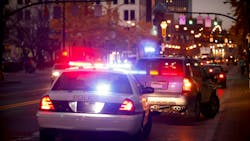Traffic Stops in Low-Light Conditions: How to Minimize the Risks
What to know
- Officers face increased risk during nighttime traffic stops because of limited visibility, delayed night vision adjustment and reduced driver awareness.
- Safety measures include choosing well-lit stop locations, notifying dispatch with full stop details, using lighting to control visibility and minimizing time outside the patrol vehicle.
- Backup officers should always be requested, and officers must avoid rushing or acting alone.
More on OFFICER.com
Download the May/June issue of OFFICER Magazine.
Click Here to subscribe to OFFICER Magazine.
It is an unfortunate reality of the job that we work anywhere from 1/3 to 2/3 of every day in less than optimal lighting conditions. That’s not due to any type of curse or special circumstance. It’s just the simple fact of daylight versus night and the fact that we work 24/7/365.
Another unfortunate reality is that there is potential risk in our work 100% of the time. But in poor lighting conditions we stand a greater chance of not seeing the risk—not seeing a threat—as quickly as we might in daylight. Further, moving from daylight into settings of low light often requires us to move quickly, not allowing our night-vision to adjust, preventing us from seeing potential threats until it’s too late or we’re way behind the curve.
The other side of that same coin is that all too often, drivers on the road can’t or don’t see us. While some agencies offer/mandate a reflective garment be worn anytime we’re outside the patrol car, most don’t and our uniforms rarely have anything reflective built into them (unless you're a bicycle or motors patrol officer). So how do we minimize our risk on traffic stops during hours of darkness, whether we’re avoiding a threat inside the vehicle we stopped or another vehicle on the road while we have to be outside our patrol vehicle?
First, pick your spot. Nothing says that you have to conduct the traffic stops immediately upon observing a violation. The stop can be miles later if need be, but pick your spot. What are you avoiding? You’re avoiding blind curves, unlit areas, narrow parts of the roadway and being on the blindside of a hill. If it’s at all possible you want a nice wide shoulder (or even better, a parking lot) with bright street lights on a flat straight road. We all know that’s not always available, but pay attention and pick your spot to maximize your safety and advantage.
Second, let’s go back to the most basic of all officer survival protocols: Make sure your dispatch center knows where you are and that you’re conducting the stop. Call in, or enter into your laptop, 1) where you are; 2) what type of vehicle you’re stopping to include make, model, color and tag; 3) how many occupants there are in the target vehicle (if you can see them).
Third, never tell dispatch that you don’t need backup. As a veteran officer, I certainly understand not wanting to call another officer to your location if everything appears “normal,” it’s a low-risk stop and it’s a busy night. Right? Well, no. There’s no such thing as a “low-risk” stop. There are only high-risk and unknown risk. A traffic stops isn’t low-risk until you’re clear of it. It hurts nothing to have another officer start your way just in case.
Fourth, use your lights to your advantage. Yes, we’ve all had times when people we’ve pulled over have complained after the fact that we “blinded them with our lights,” and it was unnecessary. Realistically speaking, that may be true. But we don’t know it was unnecessary until after the stop is concluded and we are clear. Until then, the unknown risk factor mandates that, for our own safety, we use our lights to limit what the driver or passengers of the target vehicle can see as we approach.
Fifth, look at your surroundings before exiting your vehicle. What traffic is coming toward you from either direction? How much working space do you have between your patrol vehicle and the target vehicle? How much space do you have on the road side and on the shoulder side? Determine your approach and don’t exit your vehicle until there’s no or minimal traffic threat.
Sixth, minimize any unnecessary time you spend outside your patrol vehicle. While we can’t control the circumstances of every stop and we certainly can’t control how the stop will evolve, we can be aware and conscientious of the amount of time we spend outside of our patrol vehicle. It’s not a fun idea to think about sitting in your patrol vehicle and having it struck by a moving vehicle coming from either direction, but it’s better than simply being hit by a car or truck while you’re on the roadside. At least your patrol vehicle is built to sustain impact while insulating you, the driver, from the energy of that impact.
Some follow-ups
Remember the Ten Deadly Errors and don’t violate them. If you pull over a car with multiple occupants and you have any cause to get them out and/or search the car, don’t do it alone. “Tombstone Courage,” sometimes also called “Wyatt Earp Syndrome,” can get you hurt or killed (hence the term “deadly”). Don’t rush to do something alone when you can wait for your backup. There is no need to rush to minimize the inconvenience you cause the driver you stopped. If you have no cause, then the time impact is minimal. If you have cause, the time impact is what it is required to be and 100% justified.
Remember that if you miss an opportunity to stop THIS driver for THIS violation, it’s okay. One study showed that most drivers commit a traffic violation every half-mile or so. Someone else will pull that driver over for another violation (or the same one) in a different location. There is no competition to see who can write the most tickets. There IS a mandate to go home safe at the end of your shift, so focus on that and protect yourself as necessary.
Traffic stops during the hours of darkness always hold a greater danger than those during daylight. By practicing good officer safety protocols, you can minimize your risk while still effectively doing your job.
About the Author
Lt. Frank Borelli (ret), Editorial Director
Editorial Director
Lt. Frank Borelli is the Editorial Director for the Officer Media Group. Frank brings 20+ years of writing and editing experience in addition to 40 years of law enforcement operations, administration and training experience to the team.
Frank has had numerous books published which are available on Amazon.com, BarnesAndNoble.com, and other major retail outlets.
If you have any comments or questions, you can contact him via email at [email protected].

